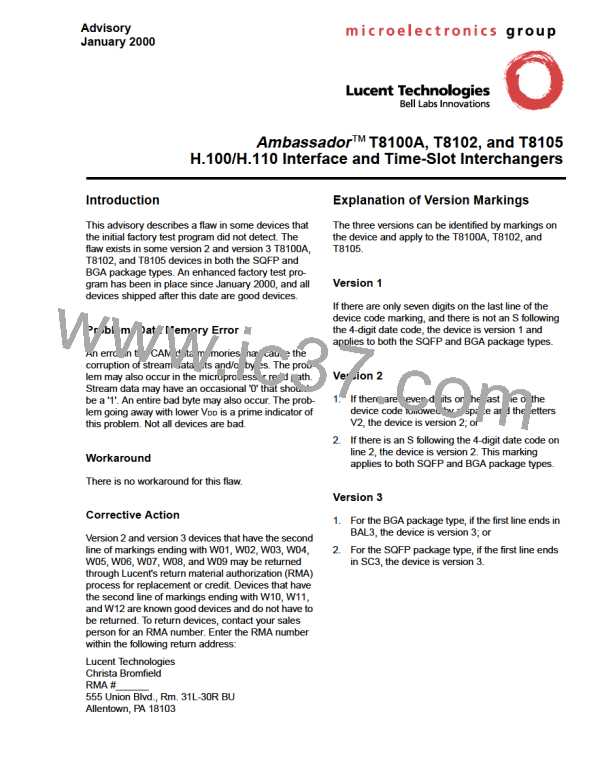Ambassador T8100A, T8102, and T8105
H.100/H.110 Interfaces and Time-Slot Interchangers
Advance Data Sheet
November 1999
2.4.3 Subrate Switching on H.100/H.110
2 Architecture and Functional Descrip-
tion (continued)
H.100/H.110 are based on byte-oriented TDM data
streams. H.100/H.110 have well-defined electrical
parameters to describe when an output driver gains
access to the bus and when it releases the bus (at the
end of the byte). There are no provisions in either
H.100 or H.110 to extend these electrical parameters
to include driving the bus on an individual bit basis, and
due to the propagation characteristics of the bus wires
on H.100, it is not desirable to attempt to drive the bus
this way.
2.4 Subrate Switching for the Ambassador
Family
2.4.1 Description, Operation, and Application
This section describes the means of implementing sub-
rate telephony switching by leveraging the existing
pipelined multistream CAM architecture. In addition,
there are implications for extending H.100/H.110 to
incorporate subrate switching without violating the
existing timing or definitions. A practical example of a
system which requires subrate switching is described
in 2.4.7 Example of a Practical Application on page 43.
Since H.100/H.110 data must always be switched as
whole bytes on H.100/H.110, subrate data will have to
be packed into the bytes prior to switching. The data
bytes are not necessarily constrained to using fully
packed bytes. Any portion of a byte may be used.
2.4.2 Definitions
An example is shown in Figure 12.
Subrate refers to switching fractional portions of the
data found in traditional TDM streams. Subrate does
not refer to changes in the bit rate, i.e., when the bit
rate changes, the total number of time slots per second
changes, but each time slot still contains data which is
propagated at the same data rate, namely 64 kbits/s.
Subrate refers to data propagated at rates less than
64 kbits/s.
n
n + 1
n + 2
n + 3
n + 4
n + 5
A1 A2 A3 A4
D1 D2 D3 D4
B1 B2 B3 B4
C1 C2 C3 C4
The data byte for a given time slot can be thought of as
two nibbles, and if each of these nibbles represents a
distinct voice or signal, then it would be correct to
say that the nibbles are operating at 32 kbits/s
(= 4 bits/frame x 8K frames/second), and that the
theoretical channel capacity of the TDM stream has
increased by a factor of two. Likewise, if the data byte
is broken into four distinct dibits, then the rate is
16 kbits/s, and the capacity of the stream has
increased by a factor of 4. Finally, in the extreme case,
a data byte is treated as 8 bits, each of which has a
rate of 8 kbits/s, which means that the stream capacity
has increased by a factor of 8.
A4 D3 B2 C1
5-7152F
Progressive assembly of the output data in a location in
the H-bus data buffer as each input subrate data piece
is received:
TIME SLOT n:
TIME SLOT n + 1:
TIME SLOT n + 2:
TIME SLOT n + 3:
A4
A4
A4
A4
X
X
X
X
X
D3
D3
D3
The above definition also leads to the concept of den-
sity. If only one piece of subrate data is used in a byte,
then it can be referred to as sparsely packed. Like-
wise, if all positions of the data byte contain subrate
data, the byte is fully packed or densely packed.
Packing thus refers to the utilization of the subrate data
positions in a byte.
X
C1
C1
B2
THE FULLY ASSEMBLED BYTE WILL BE
READ FROM THE DATA BUFFER FOR
OUTPUT DURING TIME SLOT n + 5.
Figure 12. Subrate Switching Example
Subrate switching refers to the transfer of subrate
data pieces (nibbles, dibits, or bits), just as switching
implies the transfer of data bytes. True subrate switch-
ing is the ability to move subrate data from any subrate
position to any other subrate position. Obviously, there
are restrictions which must be employed to make sub-
rate switching practical. This is discussed in the next
section.
Lucent Technologies Inc.
39

 AGERE [ AGERE SYSTEMS ]
AGERE [ AGERE SYSTEMS ]